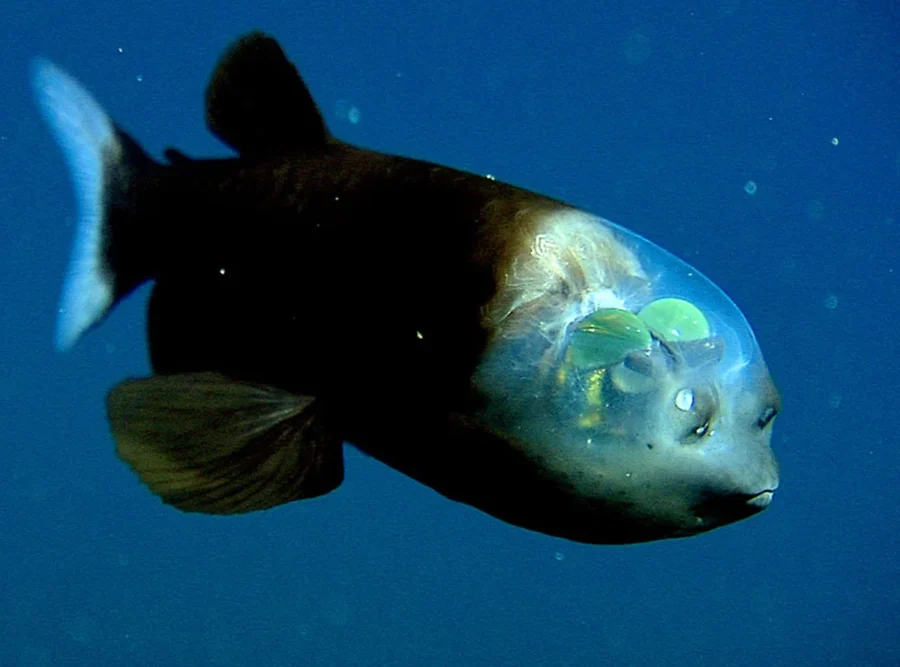Into the Abyss
Deep-Sea Fish Far down beneath the bright face of the ocean is another world as alien as the face of the world. A world of darkness, crushing pressure, and cold so bitter it solidifies into ice, the deep-sea fish is one of the most hostile environments on the planet.
And yet it teems with life—life that has adapted to live in some of the most strange, lovely, and humbling ways possible.
From radiant lanternfish to transforming octopuses, deep-sea fish are evolutionary marvels. This article takes you on a journey into the darkest depths of our oceans to introduce you to the incredible fish that call them home and to reveal the incredible adaptations that allow them to thrive in such a hostile and unforgiving environment.

The Main Challenges:
Lack of light: Sunlight doesn’t penetrate beyond about 1000 meters. Many deep-sea environments are in total darkness.
Cold temperatures: The deep sea remains near freezing, around 2–4°C (35–39°F).
High pressure: Pressure increases by about 1 atmosphere every 10 meters. At 1000 meters, the pressure is 100 times that at sea level.
Scarce food: With no sunlight, there’s no photosynthesis, and food is scarce. Most deep-sea creatures rely on “marine snow” (detritus falling from above) or on each other.
Isolation: Extreme conditions make movement and finding mates difficult.
Conditions That Shape Evolution
No Light: Vision isn’t always useful. Bioluminescence replaces sunlight.
Extreme Pressure: Fish need specialized bodies that won’t be crushed.
Scarce Food: Many species must conserve energy and eat infrequently.
Cold Temperatures: Metabolisms slow down; life moves more deliberately.
Bioluminescence—Nature’s Glow Sticks
What Is Bioluminescence?
Bioluminescence is the ability of living organisms to produce light through a chemical reaction, often involving luciferin and luciferase enzymes. This phenomenon isn’t rare — around 90% of deep-sea animals have some form of it.
Uses of Bioluminescence
Attracting Prey: Like a flashlight in the dark, bioluminescence can lure fish into the waiting jaws of predators.
Camouflage: “Counter-illumination” helps fish match the faint light from above, making them invisible from below.
Mating Signals: Some fish flash intricate light patterns to attract mates.
Defense Mechanisms: Sudden bursts of light can confuse or startle predators.
Examples
Anglerfish (Family: Lophiiformes)
Perhaps the most famous bioluminescent fish, female anglerfish dangle a glowing lure (called an esca) in front of their faces. Unsuspecting prey, mistaking it for a meal, approach — and become dinner instead.
Loosejaw Dragonfish (Genus: Malacosteus)
This predator emits red bioluminescence, which is rare in the deep sea. Why? Because most fish can’t see red light, meaning the dragonfish can see prey without being seen itself.
Lanternfish (Family: Myctophidae)
These fish are small but numerous and crucial in the ocean food web. Their bioluminescent organs help them coordinate massive, synchronised vertical migrations every night.

Jaw-Dropping Jaws—Feeding in the Dark
Expanding Stomachs and Jaws
In the deep, a meal might only come once in a while, so fish must be ready.
Black Swallower (Chiasmodon niger)
This fish can gulp prey ten times its size thanks to a stretchy stomach and unhinging jaws. Sometimes, it swallows so much that the decaying prey emits gases and makes the swallower float to the surface — where it dies.
Gulper Eel (Eurypharynx pelecanoides)
With a jaw-to-body ratio that defies logic, this eel can consume fish larger than itself. It uses its balloon-like mouth to scoop up anything it can find.
Needle Teeth and Ambush Tactics
Fangtooth (Anoplogaster cornuta)
This nightmarish fish has the largest teeth in proportion to body size of any fish. They can’t even close their mouths fully — grooves in their skulls house the fangs.
Viperfish (Chauliodus sloani)
With dagger-like teeth and a hinged skull, viperfish strike fast from below. Their photophores can flash, luring in prey for a swift kill.

Strange Shapes, Stranger Lives
Adaptations in the deep go beyond feeding and glowing — the very bodies of these fish are unlike anything else.
Transparency and Gelatinous Bodies
Without the need for camouflage, some fish just become see-through.
Glass Octopus (Vitreledonella richardi)
While not a fish, this deep-sea octopus is nearly transparent, revealing only its eyes and internal organs.
Pelican Eel
Its giant, sac-like jaw, whip-like tail, and see-through skin make it a living oddity. It moves slowly, conserving energy until prey appears.
Minimal Muscles, Maximum Efficiency
Gelatinous bodies with few muscles.
Low metabolic rates to survive on minimal food.
Slow, floating motions instead of fast swimming.
Unusual Deep-Sea Fish You Should Know
Barreleye Fish (Macropinna microstoma)
Transparent head
Rotating eyes that point upward or forward
Uses eyes to spot prey silhouetted against the faint light
Tripod Fish (Bathypterois grallator)
Perches on the ocean floor using elongated fins like a tripod
Waits motionless for prey to pass by
Can survive with minimal oxygen
Blobfish (Psychrolutes marcidus)
Internet-famous for looking like a melted human face
In deep water, it’s more compact and normal-looking
Out of water, it ”deflates”—explaining its strange appearance
Hatchetfish (Sternoptychidae)
Thin, metallic body shaped like a hatchet
Uses counter-illumination to disappear from view
It can control the intensity of its light-emitting organs
Exploring the Deep—Tools of Discovery
ROVs (remotely operated vehicles) explore where humans can’t go.
Submersibles like Alvin or Deepsea Challenger take people into the abyss.
Deep-sea cameras capture footage of creatures we’ve never seen before.

Conclusion
In the darkness of the deep sea, life whispers a different tale — one of radical adaptation, silent stamina, and unearthly beauty.
These fish, which inhabit these shallows, are not curiosities; they are evolutionary gems forged by forces that most of us can hardly fathom. From shining lures and see-through skulls to stretchy jaws and parasite partners, each deep-sea animal has a story of innovation bred from isolation. In a sunless world, with weight-squashing pressure and meagre food, to survive is to redefine the biology book.
They’ve done just that — and more — creating shapes and functions so foreign, they threaten our ideas about what life is. But as we gaze in wonder at these miracles, we also have to face an unpleasant reality: the ocean depths are no longer pristine. Human endeavors—deep-sea mining, global warming, and pollution — are infiltrating even the ocean’s most distant regions. Organisms that have taken millions of years to develop may be lost forever if we are not careful.
Deep-sea fish are survivors in the truest sense. They’ve turned darkness into opportunity, pressure into protection, and scarcity into invention.
But this mysterious world is fragile. As we advance deeper with mining and exploration, we must ask ourselves — how much of this darkness are we willing to disturb? The abyss still holds secrets — species we’ve never seen, behaviors we can’t imagine. The next discovery might change how we see evolution, life, or even ourselves.
FAQs
What exactly is considered the “deep sea”?
The deep sea generally refers to ocean depths below 200 meters (about 656 feet), where sunlight cannot penetrate. Most deep-sea life is found between 1,000 and 4,000 meters (3,280 to 13,123 feet), though some creatures live even deeper, near the ocean floor in the abyssal and hadal zones.
How do deep-sea fish survive without sunlight?
Without sunlight, deep-sea fish rely on bioluminescence, enhanced sensory organs, and slow metabolisms to survive. Many feed on marine snow (tiny particles falling from above), scavenge carcasses, or hunt using clever adaptations like light-producing lures.
Why do so many deep-sea creatures glow in the dark?
Attract prey (like the anglerfish)
Communicate with mates
Confuse predators or camouflage themselves in the dark
It’s a brilliant example of how life adapts when vision is nearly useless.
Are deep-sea fish dangerous to humans?
Most deep-sea fish are not dangerous to humans. In fact, many are fragile and wouldn’t survive the pressure change if brought to the surface. However, some have sharp teeth or venomous spines, so handling them (when possible) requires care, mostly by scientists.
Why do deep-sea fish often look so strange or scary?
Their strange appearances are perfectly suited to the extreme environment they live in. Huge eyes, fang-like teeth, bloated stomachs, or transparent bodies might seem odd, but each trait plays a vital role in helping them:
Eat efficiently
Hide from predators
Reproduce in near-impossible conditions
Can deep-sea fish be kept in aquariums?
Almost never. Deep-sea fish are adapted to immense pressure, cold temperatures, and darkness. Bringing them to the surface can be fatal. A few exceptions, like the barreleye or some deep-sea jellyfish, have been displayed under special conditions in research facilities, but it’s extremely rare.
What is the most famous deep-sea fish?
It became popular in pop culture thanks to documentaries and animated films. Its bizarre appearance and mating strategy (where males fuse with females) make it a favorite for curious minds.
How do deep-sea fish reproduce in such isolated places?
It became popular in pop culture thanks to documentaries and animated films. Its bizarre appearance and mating strategy (where males fuse with females) make it a favorite for curious minds.
What do deep-sea fish eat?
Marine snow (dead organic matter falling from above)
Other fish and crustaceans
Whale falls (sunken whale carcasses)
Plankton and small invertebrates
Food is scarce, so many deep-sea fish are opportunistic eaters—they’ll eat anything they can catch or find.










